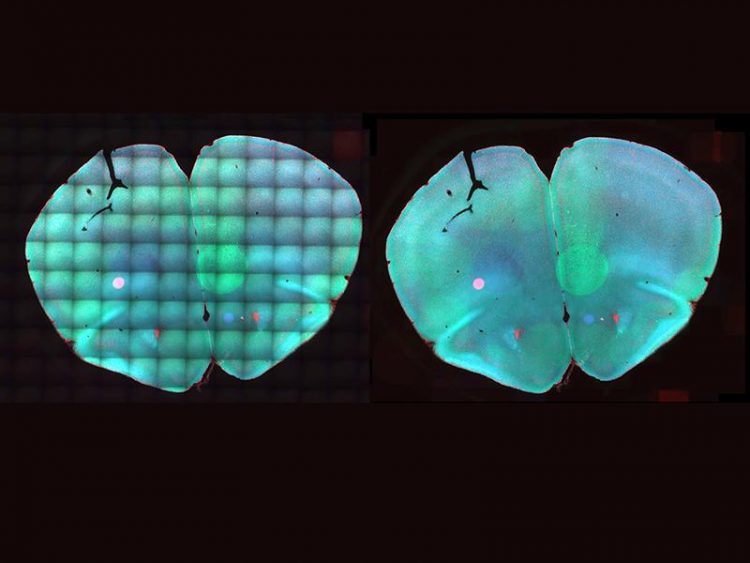Image correction software simplifies quantification of stem cells

Mosaic image of a mouse brain slice improved by the software BaSiC. Image: Tingying Peng / TUM/HMGU
When stem cells develop into specialized cells, this happens in multiple steps. But which regulatory proteins are active during the decisive branching on the development path? Using so-called time-lapse microscopy, researchers can observe individual cells at very high time resolutions and, using fluorescent labelling, they can recognize precisely which of these proteins appear when in the cell.
Once a stem cell has been identified, it can be closely observed over several days using cell-tracking software. Yet, this “surveillance work” often turns out to be difficult. “The imaging data is frequently marred by irregular brightness and faded backgrounds in the time-lapse,” explains Dr. Carsten Marr, heading the workgroup Quantitative Single Cell Dynamics at the Institute of Computational Biology (ICB) of the Helmholtz Zentrum München. “This makes it difficult or impossible to detect proteins that are decisive when a cell opts for a specific development direction, so-called transcription factors.”
Algorithms that filter out these kinds of artefacts exist, but they require either specifically prepared reference images, many images per dataset or complex manual adjustments. Furthermore, none of the existing methods correct alterations in the background over time, which hamper the quantification of individual cells.
Algorithm eliminates background changes
Now, Dr. Tingying Peng, member of Dr. Carsten Marr’s group at the Helmholtz Zentrum München and Professor Nassir Navab, head of the Chair for Computer Aided Medical Procedures and Augmented Reality at TU Munich, present an algorithm that corrects these artefacts using only a few images per dataset.
The software is called “BaSiC” and is freely available. It is compatible with many image formats commonly used in bioimaging, including mosaics pieced together from numerous smaller images and used, for example, to render large tissue regions. “Contrary to other programs, however,” explains Dr. Peng, “BaSiC can correct changes in the background of time-lapse videos. This makes it a valuable tool for stem cell researchers who want to detect the appearance of specific transcription factors early on.”
Bringing significant details to light
How well the new image correction program improves the analysis of individual stem cell development steps the scientists demonstrated with time-lapse videos of blood stem cells. They recorded the videos to observe cells over a six-day time span. At a certain point during this observation period undifferentiated precursor cells choose between two possible tacks of development that lead to the formation of different mature blood cells.
In images corrected using BaSiC, the researchers could identify a substantial increase in the intensity of a specific transcription factor in one of the two cell lines, while the amount of his protein in the other cell line remained unchanged. Without the image correction, the difference was not ascertainable.
“Using BaSiC, we were able to make important decision factors visible that would otherwise have been drowned out by noise,” says Nassir Navab. “The long-term goal of this research is to facilitate influencing the development of stem cells in a targeted manner, for example to cultivate new heart muscle cells for heat-attack patients. The novel possibilities for observation are bringing us a step closer to this goal.”
The BaSiC image correction program resulted from a close collaboration between the Chair of Mathematical Modeling of Biological Systems and the Chair of Computer Aided Medical Procedures & Augmented Reality at the Technical University of Munich and the Institute of Computational Biology (ICB) of the Helmholtz Zentrum München. Also involved were the Department of Biochemistry and Biophysics at the University of California in San Francisco (USA), as well as the Department of Biosystems Science and Engineering (D-BSSSE) at ETH Zürich and the Chair of Computer Aided Medical Procedure at Johns Hopkins University in Baltimore (USA).
Publication
Tingying Peng, Kurt Thorn, Timm Schroeder, Lichao Wang, Fabian J. Theis, Carsten Marr and Nassir Navab. BaSiC: A Tool for Background and Shading Correction of Optical Microscopy Images.
Nature Communications 8, 14836 (2017) – DOI: 10.1038/ncomms14836
https://www.nature.com/articles/ncomms14836
Contact
Dr. Carsten Marr
ICB Institute of Computational Biology
Helmholtz Zentrum München
Ingolstädter Landstr. 1, 85764 Neuherberg, Germany
Tel.: +49 89 3187 2158 – e-mail: carsten.marr@helmholtz-muenchen.de
Web: http://bit.ly/2qVMp2w – Software: http://bit.ly/2sm2WfH
Prof. Dr. Nassir Navab
Chair for Computer Aided Medical Procedures and Augmented Reality
Technical University of Munich
Boltzmannstr. 3, 85748 Garching, Germany
Tel.: 089 289 17057 – e-mail: nassir.navab@tum.de – web: http://campar.in.tum.de/Main/NassirNavab
https://www.tum.de/en/about-tum/news/press-releases/detail/article/33987/ Link to the press release
Media Contact
All latest news from the category: Life Sciences and Chemistry
Articles and reports from the Life Sciences and chemistry area deal with applied and basic research into modern biology, chemistry and human medicine.
Valuable information can be found on a range of life sciences fields including bacteriology, biochemistry, bionics, bioinformatics, biophysics, biotechnology, genetics, geobotany, human biology, marine biology, microbiology, molecular biology, cellular biology, zoology, bioinorganic chemistry, microchemistry and environmental chemistry.
Newest articles

NASA: Mystery of life’s handedness deepens
The mystery of why life uses molecules with specific orientations has deepened with a NASA-funded discovery that RNA — a key molecule thought to have potentially held the instructions for…

What are the effects of historic lithium mining on water quality?
Study reveals low levels of common contaminants but high levels of other elements in waters associated with an abandoned lithium mine. Lithium ore and mining waste from a historic lithium…

Quantum-inspired design boosts efficiency of heat-to-electricity conversion
Rice engineers take unconventional route to improving thermophotovoltaic systems. Researchers at Rice University have found a new way to improve a key element of thermophotovoltaic (TPV) systems, which convert heat…



